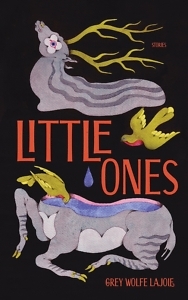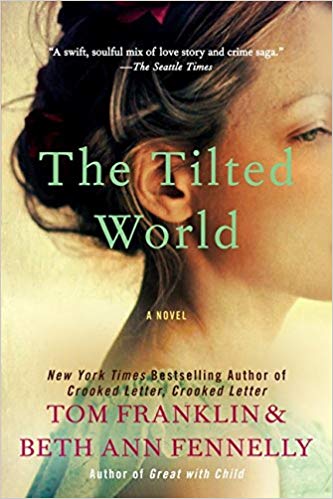Eyes in the Shadows
Tales of death and loss mark Grey Wolfe LaJoie’s unconventional story collection
Grey Wolfe LaJoie’s literary debut, Little Ones, is a unique collection of short stories and graphic ephemera. Readers have the pleasure of meeting the title character of “Maria,” a little girl with absent parents who lives in a house alone and watches old boxing matches. The unnamed protagonist of “The Locksmith” has trouble speaking but perhaps understands the world better than those around him. A journalist reevaluates his life in “Interview with the Pope,” and “Ampersand Jansen” follows its eccentric title character into a church to confess his sins, only to have his horse suffer a terrible fate.

The characters in Little Ones are more than their quirks. They read as flesh-and-blood individuals LaJoie seems to have stopped on their travels to receive their stories. The tales are heartbreaking and moving, insightful and frightening. We could spend decades learning from them.
Grey Wolfe LaJoie is a native of Western North Carolina and currently works for Auburn University’s Alabama Prison Arts & Education Project. They answered questions about Little Ones by email.
Chapter 16: Many of the characters in your stories have unique voices, yet there is also a connecting theme of grief-stricken ennui throughout. How did you manage to balance these differences and similarities in both characters and themes in the collection so effectively?
Grey Wolfe LaJoie: If I have talent as a writer, it’s in polyvocality: so many different voices! Really the characters, and their voices, have always been the parts of fiction that I have the most reverence toward. I really try to meditate on what they want, try to respect their personhood. As strange as it might sound to some, it’s always been the point of fiction for me, the part of the practice that is the most spiritual. So I end up with a whole carnivalesque cacophony of personalities. And what I find is that, no matter how inward or ostentatious a character is, no matter how well intentioned or irresponsible, cherished or abandoned, there is a lot of pain and an enduring will to go beyond it.
I am also always drawn to those who have been cast to the shadows of society, for one reason or another, and there is probably a touch more sadness — as well as more transcendence — in those spaces. While suffering is an inherent part of life, it’s not what life is about. I think it’s about how we rise above that suffering, together, or don’t.
Chapter 16: In addition to traditional short stories, your collection contains illustrations and other creative elements labeled “graphic ephemera.” Can you discuss the process of how these other elements came to be and how you incorporated them into the collection?
LaJoie: Occasionally, while I’m writing, I will begin to feel this sense of performativity, a sense that I am only going through the motions to achieve a certain outcome, a product. The real work of it then, the process, begins to feel plodding, mechanical, and, when this happens, something inside of me gets very restless and simply does not cooperate. What’s the point of writing this way! a little voice inside me screams. You might as well be assembling a shelf!
My solution is to completely upend whatever clean image has begun to take shape. Sometimes, as in the case of “Snek & Goose,” the children’s fable I thought I was writing suddenly becomes a distorted memoir-as-bedtime-story; sometimes, as in the case of “Frank,” my protagonist begins to backtalk me (the writer and the narrator both) and rebels against whatever plot I lay before him, against my own sense of control; and sometimes, as in the case of a number of these pieces, I do exactly what I did as a restless student all through middle and high school: I take the pen that’s been given me and start to draw. The real joy for me is in bringing these disruptions — these internal rebellions — back into harmony with the greater composition of the piece. This also means I can convey a more capacious truth about myself, the push and the pull both. I think when people see such formal play, they tend to assume that someone is being tricky. For me, at least, it’s just the opposite. One of my goals in my work, always, is to be as honest as possible, to show you the process as it unfolds.
Chapter 16: You work for Auburn University’s Alabama Prison Arts & Education Project teaching creative writing. How has this experience influenced your own creative writing?
LaJoie: More than anything else, this work has reinforced for me the power and importance of levity, the absolute pragmatism of play. By “levity,” I don’t mean the kind of flippantly avoidant escapism, the willful ignorance in the face of gravity, which that word more often evokes these days. I mean real levity, a lifting up in the midst of something grave, rising through it. This book, and my writing in general I think, often possesses an unusual mixture of, on the one hand, a grave and dark intensity, and on the other a childlike whimsy, a playful and musical mischief. This kind of admixture is something I probably first gleaned from my own family growing up — a family in Western North Carolina heavily impacted by poverty, addiction, criminality, and mental illness, which was nonetheless full of humor — but it was not something I fully grasped until I began to go inside of Alabama’s prison system.
It must be said that, because of its history, and because of the profound levels of denial and avoidance that the state undergoes to avoid its history, these prisons are the sites of some of the most dire conditions in our country today, some of the most catastrophic violations of human rights. Yet in spite of this, the people I interact with — the students I come to know each day in class, as well as other incarcerated individuals — are so full of lightness, full of jokes, music, stories, creative power, but most of all they’re exceptionally full of laughter.
This is not merely a salve, this sense of humor and play, not merely a way to lessen the pain. The levity that pours forth from these folks is precisely how they sustain and restore their humanity, their power — a real, spiritual power. They are not avoiding the grave reality — far from it! The truth of their condition is fused with their spirit of play — it’s of a piece. That’s how they stay so real. I think it’s how they stay sane. Under such constraints, for individuals who have been stripped of everything, their families, their futures, their self-reliance, this is a necessity. In art I believe it is, too.
Chapter 16: The little girl in perhaps the longest story in the collection, “Maria,” is very reminiscent of Wednesday Addams from the Addams family. Was the story inspired by the Addams family or similar characters in any way?
 LaJoie: Ha! Well, I haven’t watched the new TV series yet, Wednesday, but the original Addams Family sitcom from the ‘60s was my favorite show when I was 4 or 5 — it used to come on every night in syndication, right after The Munsters — and I’m sure this show had an unconscious influence on me. (Personally, I always felt the deepest kinship with Thing.) Really, though, I think I find the character of any precocious and jaded child to be particularly resonant, partly because I was one and partly because of the ways they embody everything I was talking about above: levity interwoven with gravity, innocence with experience.
LaJoie: Ha! Well, I haven’t watched the new TV series yet, Wednesday, but the original Addams Family sitcom from the ‘60s was my favorite show when I was 4 or 5 — it used to come on every night in syndication, right after The Munsters — and I’m sure this show had an unconscious influence on me. (Personally, I always felt the deepest kinship with Thing.) Really, though, I think I find the character of any precocious and jaded child to be particularly resonant, partly because I was one and partly because of the ways they embody everything I was talking about above: levity interwoven with gravity, innocence with experience.
So many of us who experienced trauma and instability in our youth seem always to have lived with this paradoxical overlay — I think it’s common, maybe especially, for artists. That may be why characters like Wednesday Addams are so beloved. When Maria came into my mind, I think it presented a way to explore this paradoxical experience in greater depth. In one sense she is truly helpless to the world, and yet she is also honing something cool and sharp and secret, which takes her far from here. “Snek & Goose” gets at a similar dualism — children bearing witness to the soiled, blistered world, while at the same time retaining something within that is imperishable and sweet. That the two divergent vantages would be separate feels almost unnatural to me; it feels more authentic when I find a character who embodies the wisdom and naivety together.
Chapter 16: I’m dying to know more about the construction process of “Interview with the Pope.” Can you discuss how this story came into being and what inspired it?
LaJoie: This is the first story I gave myself permission to doodle in, so to speak. It’s the oldest story in the collection, and it represents a period of intense struggle, internal wrestling. I was desperate at that time for a spiritual guide, someone or something, anything, that could provide levity or light. I guess that’s how this character ends up going to interview the pope (I should say, ‘a pope,’ because it’s a highly fantastical figure based on no one in particular). It’s important to note that I’m a very linear writer — I go from beginning to end — and the sense of surprise for me along the way is a crucial part of the process. So, once I found myself in the position of having to imagine what this imperfect guide might do or say, I was astonished to see, rather than words, drawings appear on the page.
That story ends with a scene in which someone is reading an old children’s book, The Tawny Scrawny Lion. The experience I had of children’s books has always been the mark I strive toward. I do not mean children’s books themselves, but the experience we have of them as children, which for me was incredibly rich with imaginative engagement and possibility. The return this story took, to the wonder and inhibition of childhood, was a kind of revelation for me personally, and so it gave me some of what I was looking for.
Chapter 16: If you had the opportunity to share your hopes, dreams, and goals for the book with potential readers, what would you want to tell them?
LaJoie: More than anything else, I want to give people permission. I certainly cherish art the most when it gives me an expanded sense of possibility, for myself and for those I love, and that is what I want this book to do. This book, as I said before, is particularly interested in those who are cast into the shadows, and I’m very interested in what it is, or who it is, that we assign to the shadows. Because of a person’s identity, because of their ability or their station, assumptions are made about their value — their moral worth — and the result is not simply that they are seen as inferior; in the mind of another, this person often sits in the negative space, society’s negative space — unseen and without meaning — a kind of absence, a vacuum. But the person who is believed to have nothing to say, nothing to contribute, merely because his articulation is disregarded and deterred — this person in fact contains universes, libraries, infinite worlds of truth and beauty, which nowhere else exist.
What drives me most crazy is the way that — discouraged from speaking or acting and convinced by the world that their agency is poisonous — some will dishonor this reality inside themselves. If the book could interrupt that process in just one person, give them back some audacity, then it will have been successful in my mind.

Abby N. Lewis is from Dandridge, Tennessee. She is the author of the full-length poetry collection Reticent and the chapbooks This Fluid Journey and Palm Up, Fingers Curled.





